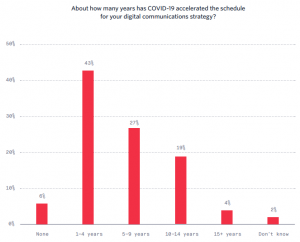Pandemic has accelerated DX by 6 years, says Twilio

- A report found that almost all digital transformation projects were accelerated due to the pandemic
- Companies worldwide were also found to be seeking alternative digital communications
- The adopted digital communications channel could pave way for future remote working opportunities
The coronavirus outbreak has expedited the need for businesses to ramp up their digitization efforts and respond to an unprecedented change in organizational structure (mass remote working), changing customer behavior, and evolving market risks. Digital transformation efforts are now the key enabler for companies to cope and steady their positions in an ever-shaking economy.
The impact has led to longer term strategies to be re-assessed and often condensed to meet the immediate need of organizations.
This was reflected in the COVID-19 Digital Engagement Report by Twilio, a cloud communications and customer engagement platform.
The report gathered responses from 2,569 enterprise decision-makers in major regions such as APAC, Europe, and America to capture the impact of COVID-19 on digital initiatives. The major takeaway — 97% of enterprises hit the accelerator in digitalization projects, and more than half (68%) expressed the pandemic has sped up their digital efforts “a great deal.”
The surveyed companies shared that COVID-19 had accelerated their digital communication strategy by a global average of 6 years, as illustrated below.

Source: Twilio
In the thick of the pandemic, companies were grappling with resuming business operations and finding their footing in work from home arrangement, ensuring the safety of employees while sustaining daily workflow. A crucial component in this transition to flexible remote working is communications technology.
“Communications technology is at the heart of this transition to a flexible remote working model for employees, and a seamless, digital customer experience for businesses at large.” said David Parry-Jones, vice president, EMEA at Twilio.
Not just limited to communication at work, companies were also seeking ways to engage with partners, customers, and the overall wider community of the economy.
The pandemic has pushed forward the case for businesses to adopt omnichannel communications, as 95% of respondents expect their organizations to seek new ways of engaging with customers and stakeholders.
A study by TrustRadius revealed that about 30% of enterprise spend on technology is simply on video and web conferencing software.
Twilio’s report also indicated digital communications via live chats, emails, and videos have monumentally increased during the pandemic.
This could attribute to the increased investments in communication technology as businesses recognize the value and importance of omnichannel interactions. These forms of digital communications could become the standard of communication in the future.
Glenn Weinstein, chief customer officer at Twilio, noted: “Over the last few months, we’ve seen years-long digital transformation roadmaps compressed into days and weeks in order to adapt to the new normal as a result of COVID-19.
“Our customers in nearly every industry have had to identify new ways to communicate with their customers and stakeholders – from patients, to students, to shoppers, and even employees – essentially overnight.”
In the end, almost all (99%) of enterprises agree that digital technologies adopted to enable and sustain work from the home arrangement will open up future opportunities to remote working.
Tech companies as well envision remote working to be a new norm as Microsoft launches new features of Teams, aimed to battle virtual meeting fatigue, and Twitter has made work-from-home a permanent option for employees.










